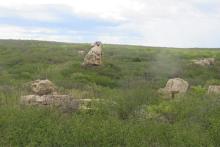Gold Mountain has applied for 57 exploration licences enclosing more than 100,000 hectares of rare earths terrain in Brazil ¬– and the ground sits right next to a major inferred 510.3-million-tonnes-resource. The company’s new “Down Under” project in the State of Bahia is partly contiguous with Brazilian Rare Earths’ tenure and a resource with an overall grade of 1513ppm total rare earth oxides.


Gold Mountain has applied for 57 exploration licences enclosing more than 100,000 hectares (1000 square kilometres) of rare earths terrain in Brazil – and the ground sits right next to a major inferred 510.3-million-tonnes-resource.
The company’s new “Down Under” project in the State of Bahia is partly contiguous with the Gina Rinehart-backed Brazilian Rare Earths’ (BRE) tenure and a resource with an overall grade of 1513 parts per million total rare earth oxides (TREO).
Management has settled on the project name in reference to the dominance of Australian explorers in the region. It consists of three major tenement groups made up of mostly contiguous licences, in addition to a further three smaller areas comprising either groups of or single licence applications, east and south of the principal coverage. It also abuts ASX-listed Equinox Resources, mostly on its eastern boundaries.
Importantly, the main block of ground is less than 40km – and as close as 5km – south of seven defined rare earths deposits in BRE’s tenure that comprises its Rocha da Rocha rare earths project.
BRE is heading towards an initial public offering (IPO) to list on the ASX and is looking at a JORC-compliant exploration target of between 8 and 12 billion tonnes at about 1000ppm to 1500ppm TREO.
Canaccord Genuity and Petra Capital are working to raise $50 million for the listing. At an issue price of $1.47 per share in the IPO, BRE will have a market capitalisation of $315 million, with Rinehart’s Hancock Prospecting holding about 6 per cent.
While other players in Brazil seem to be focussed primarily on ionic clay-hosted rare earths, BRE’s resource is divided between 25 million tonnes of high-grade monazite sands running at about 10,022ppm TREO and ionic-clay type mineralisation averaging about 1000ppm.
However, the Brazil story seems to be about its emergence as potentially the most important source of attractive, low-cost ionic clay deposits outside China.
Interestingly, Equinox recently revealed its latest strategic move to establish dominance in Brazil's rare earths sector. It has also submitted pegging applications for about 1760sq km of rare earths tenements in Bahia, some of which may end up competing with Gold Mountain’s applications.
The latter’s applications have been based largely on the company’s review of particular mapped major structures and shears in its tenements, which are geologically and geochemically similar to those in the BRE ground.
Gold Mountain’s rationale is that the structures, described as strike slip or transpressive faults, were likely conduits for intrusion of hydrothermal rare earths mineralisation and mafic-ultramafic rare earths mineralised bodies. Management believes they could be the source of clay rare earths deposits derived by weathering of the primary host rocks.
The company says a high proportion of magnet rare earths oxides (MREO) is also present in local mineralisation and is important for the value of concentrate recovered from the ore.
Typically MREO include neodymium, praseodymium, dysprosium and terbium, which are of value in the production of permanent magnets used in electric vehicles. It is estimated that MREO by value could make up about 98 per cent of the market in 2030.
Despite the lower average grades, clay-hosted rare earths deposits – especially those with high MREO content – are in high demand for the global green energy transition because they are typically from shallow depths and are less capital-intensive to mine than hard-rock deposits.
They are also often free-digging and significantly, porous enough to allow solvent-based in situ mining, meaning high-volume earthmoving is not required and solvent extraction can also be designed to target specific elements.
Additionally, the typically lower grade of clay-hosted deposits is often offset by potential tonnages that can be orders of magnitude greater than their hard-rock equivalents.
Brazil offers a premier mining jurisdiction with a rich resource base, extensive high-quality infrastructure and a supportive legislative regime – and Gold Mountain appears to be tapping into it hard.
The company’s future exploration is expected to include geomorphological studies to assess weathering profile preservation, stream-sediment sampling, geological and radiometric mapping in minor drainages and identification of target areas for soil auger sampling and rock-chip sampling. And it will all be followed by drilling in high-priority target areas to try and establish exactly what it has in its tenure.
Is your ASX-listed company doing something interesting? Contact: matt.birney@businessnews.com.au












